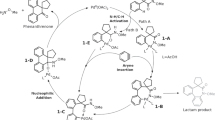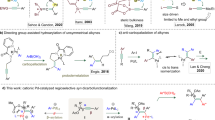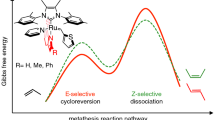Abstract
A quantum-chemical study based on the Kohn–Sham density functional theory (DFT) has been performed in order to investigate the asymmetric Heck–Matsuda (HM) reactions involving a chiral N,N ligand pyrimidine-oxazoline. The oxidative addition (OA) of arenediazonium cation was analyzed to provide further insights in the unexpected high reactivity of N,N-ligated palladium(0)-based catalysts observed in these HM processes. DFT calculations suggest that the ionogenic nature of metal center promoted by the arenediazonium cation addition increases the electronic reactivity of palladium(0) toward the donor N,N ligand. The concerted and multi-step mechanisms were computed for the OA step, in which the cationic aryl-palladium(II) complex formation was revealed as the thermodynamic driving force for this process. The importance of conformational analyses was highlighted, particularly when an acyclic alkenol olefin is taken as substrate, since its absence could lead to misleading predictions about the selectivity of these HM systems. While the enantioselectivity is controlled by the combination of steric and dispersion interactions between ligand and substrate, the regioselectivity is mostly oriented by the electronic nature of olefinic carbons. DFT predictions on the selectivity were shown to be in quantitative agreement with experimental results.






Similar content being viewed by others
References
Heck RF (1982) Palladium-catalyzed vinylation of organic halides. Org React 27:345
Beletskaya IP, Cheprakov AV (2000) The Heck reaction as a sharpening stone of palladium catalysis. Chem Rev 100:3009
Amatore C, Jutand A (2000) Anionic Pd(0) and Pd(II) intermediates in palladium-catalyzed Heck and cross-coupling reactions. Acc Chem Res 33:314–321
Knowles JP, Whiting A (2007) The Heck-Mizoroki cross-coupling reaction: a mechanistic perspective. Org Biomol Chem 5:31–44
Oestreich M (2009) The Mizoroki–Heck reaction. In: Oestreich M (ed), vol 1, Wiley, Chichester
Mizoroki T, Mori K, Ozaki A (1971) Arylation of olefin with aryl iodide catalyzed by palladium. Bull Chem Soc Jpn 44:581
Heck RF, Nolley JP (1972) Palladium-catalyzed vinylic hydrogen substitution reactions with aryl, benzyl, and styryl halides. J Org Chem 37:2320–2322
Mori K, Mizoroki T, Ozaki A (1973) Arylation of olefin with iodobenzene catalyzed by palladium. Bull Chem Soc Jpn 46:1505–1508
Shibasaki M, Boden CDJ, Kojima A (1997) The asymmetric Heck reaction. Tetrahedron 53:7371–7395
Dounay AB, Oberman LE (2003) The asymmetric intramolecular Heck reaction in natural product total synthesis. Chem Rev 103:2945–2964
Bartók M (2010) Unexpected inversions in asymmetric reactions: reactions with chiral metal complexes, chiral organocatalysts, and heterogeneous chiral catalysts. Chem Rev 110:1663–1705
Roglans A, Pla-Quintana A, Moreno-Mañas M (2006) Diazonium salts as substrates in palladium-catalyzed cross-coupling reactions. Chem Rev 106:4622–4643
Taylor JG, Moro AV, Correia CRD (2011) Evolution and synthetic applications of the Heck-matsuda reaction: the return of arenediazonium salts to prominence. Eur J Org Chem 2011:1403–1428
Felpin F-X, Nassar-Hardy L, Callonnec FL, Fouquet E (2011) Recent advances in the Heck–Matsuda reaction in heterocyclic chemistry. Tetrahedron 67:2815
Cartney DM, Guiry PJ (2011) The asymmetric Heck and related reactions. Soc Rev 40:5122–5150
Correia CRD, Oliveira CC, Salles AG Jr, Santos EA (2012) The first examples of the enantioselective Heck–Matsuda reaction: arylation of unactivated cyclic olefins using chiral bisoxazolines. Tetrahedron Lett 53:3325–3328
Oliveira CC, Angnes RA, Correia CRD (2013) Intermolecular enantioselective Heck-matsuda arylations of acyclic olefins: application to the synthesis of β-aryl-γ-lactones and β-aryl aldehydes. J Org Chem 78:4373–4385
Silva AR, Polo EC, Martins NC, Correia CRD (2018) Enantioselective oxy-Heck–matsuda arylations: expeditious synthesis of dihydrobenzofuran systems and total synthesis of the neolignan (−)-conocarpan. Adv Synth Cat 360:346–365
Carmona RC, Köster OD, Correia CRD (2018) Chiral N,N′ ligands enabling palladium-catalyzed enantioselective intramolecular Heck–Matsuda carbonylation reactions by sequential migratory and CO insertions. Angew Chem Int Ed 57:12067–12070
Reddi Y, Tsai C, Avila CM, Toste FD, Sunoj RB (2019) Harnessing noncovalent interactions in dual catalytic enantioselective Heck–Matsuda arylation. J Am Chem Soc 141:2998
Kattela S, de Lucca EC, Correia CRD (2018) Enantioselective synthesis of phthalides and isochromanones via Heck–Matsuda arylation of dihydrofurans. Chem Eur J 24:17691–17696
Hu H, Teng F, Liu J, Hu W, Luo S, Zhu Q (2019) Enantioselective synthesis of 2-oxindole spirofused lactones and lactams by Heck/carbonylative cyclization sequences: method development and applications. Angew Chem Int Ed 58:9225–9229
Werner EW, Mei T-S, Burckle AJ, Sigman MS (2012) Enantioselective Heck arylations of acyclic alkenyl alcohols using a redox-relay strategy. Science 338:1455–1458
Oliveira CC, Pfaltz A, Correia CRD (2015) Quaternary stereogenic centers through enantioselective Heck arylation of acyclic olefins with aryldiazonium salts: application in a concise synthesis of (R)-verapamil. Angew Chem Int Ed 54:14036–14039
Cabri W, Candiani I (1995) Recent developments and new perspectives in the Heck reaction. Acc Chem Res 28:2–7
von Schenck H, Kermark B, Svensson M (2003) Electronic control of the regiochemistry in the Heck reaction. J Am Chem Soc 125:3503–3508
Deeth RJ, Smith A, Brown JM (2004) Electronic control of the regiochemistry in palladium-phosphine catalyzed intermolecular Heck reactions. J Am Chem Soc 126:7144–7151
Felpin F-X, Miqueu K, Sotiropoulos J-M, Fouquet E, Ibarguren O, Laudien J (2010) Temperature, ligand- and base-free Heck reactions of aryl diazonium salts at low palladium loading: sustainable preparation of substituted stilbene derivatives. Chem Eur J 16:5191–5204
Shen J, Xu B, Su M, Zhang W (2018) Branched-selective decarboxylative Heck reaction with electronically unbiased olefins. Eur J Org Chem 2018:2768–2773
Wang Y, Qu S, Wang Z, Wang X (2014) A computational mechanistic study of an unprecedented Heck-type relay reaction: insight into the origins of regio- and enantioselectivities. J Am Chem Soc 136:986–998
Xu L, Hilton MJ, Zhang X, Norrby P-O, Wu Y-D, Sigman MS, Wiest O (2014) Mechanism, reactivity, and selectivity in palladium-catalyzed redox-relay Heck arylations of alkenyl alcohols. J Am Chem Soc 136:1960–1967
Hilton M, Xu L-P, Norrby P-O, Wu Y-D, Wiest O, Sigman MS (2014) Investigating the nature of palladium chain-walking in the enantioselective redox-relay Heck reaction of alkenyl alcohols. J Org Chem 79:11841–11850
Kohn W, Sham L (1965) Self-consistent equations including exchange and correlation effects. J Phys Rev 140:A1133
Yu HS, Li SL, Truhlar D (2016) Perspective: Kohn–Sham density functional theory descending a staircase. J. Chem. Phys 145:130901
Gaussian 09, Revision D.01, Frisch MJ, Trucks GW, Schlegel HB, Scuseria GE, Robb MA, Cheeseman JR, Scalmani G, Barone V, Mennucci B, Petersson GA, Nakatsuji H, Caricato M, Li X, Hratchian HP, Izmaylov AF, Bloino J, Zheng G, Sonnenberg JL, Hada M, Ehara M, Toyota K, Fukuda R, Hasegawa J, Ishida M, Nakajima T, Honda Y, Kitao O, Nakai H, Vreven T, Montgomery JA, Jr, Peralta JE, Ogliaro F, Bearpark M, Heyd JJ, Brothers E, Kudin KN, Staroverov VN, Kobayashi R, Normand J, Raghavachari K, Rendell A, Burant JC, Iyengar SS, Tomasi J, Cossi M, Rega N, Millam JM, Klene M, Knox JE, Cross JB, Bakken V, Adamo C, Jaramillo J, Gomperts R, Stratmann RE, Yazyev O, Austin AJ, Cammi R, Pomelli C, Ochterski JW, Martin RL, Morokuma K, Zakrzewski VG, Voth GA, Salvador P, Dannenberg JJ, Dapprich S, Daniels AD, Farkas Ö, Foresman JB, Ortiz JV, Cioslowski J, Fox DJ (2009) Gaussian, Inc., Wallingford CT
Zhao Y, Truhlar D (2008) The M06 suite of density functionals for main group thermochemistry, thermochemical kinetics, noncovalent interactions, excited states, and transition elements: two new functionals and systematic testing of four M06-class functionals and 12 other functionals. Theor Chem Acc 120:215–241
Sperge T, Sanhueza IA, Kalvet I, Schoenebeck F (2015) Computational studies of synthetically relevant homogeneous organometallic catalysis involving Ni, Pd, Ir, and Rh: an overview of commonly employed DFT methods and mechanistic insights. Chem Rev 115(17):9532–9586
Aoto Y, de Lima Batista AP, Köhn A, de Oliveira-Filho AGS (2017) how to arrive at accurate benchmark values for transition metal compounds: Computation or experiment? J Chem Theory Comput 13(11):5291–5316
Begner A, Dolg M, Küchle W, Stoll H, Preu H (1993) Ab initio energy-adjusted pseudopotentials for elements of groups 13–1. Mol Phys 80:1431–1441
Weigend F, Ahrichs R (2005) Balanced basis sets of split valence, triple zeta valence and quadruple zeta valence quality for H to Rn: design and assessment of accuracy. Phys Chem Chem Phys 7:3297–3305
Hratchian HP, Schlegel HB (2005) Using hessian updating to increase the efficiency of a hessian based predictor-corrector reaction path following method. J Chem Theory Comp 1:61–69
Marenich AV, Cramer CJ, Truhlar D (2009) Universal solvation model based on solute electron density and on a continuum model of the solvent defined by the bulk dielectric constant and atomic surface tensions. J Phys Chem B 113:6378–6396
Farshadfar K, Chipman A, Hosseini H, Yates BF, Ariafard A (2019) A modified cationic mechanism for PdCl2-catalyzed transformation of a homoallylic alcohol to an allyl ether. Organometallics 38:152953–152962
Ansell MB, Menezes da Silva VH, Heerdt G, Braga AAC, Spencer J, Navarro O (2016) An experimental and theoretical study into the facile, homogenous (N-heterocyclic carbene) 2-Pd (0) catalyzed diboration of internal and terminal alkynes. Catal Sci Technol 6:7461–7467
Reed A, Curtiss LA, Weinhold F (1988) Intermolecular interactions from a natural bond orbital, donor-acceptor viewpoint. Chem Rev 88:6899–6926
Bäcktorp C, Norrby P-O (2010) Trans effects in the Heck reaction—a model study. J Mol Catal A Chem 328:108–113
Henriksen ST, Norrby P-O, Kaukoranta P, Andersson PG (2008) Combined experimental and theoretical study of the mechanism and enantioselectivity of palladium- catalyzed intermolecular Heck coupling. J Am Chem Soc 130:10414–10421
Menezes da Silva VH, de Lima Batista AP, Navarro O, Braga AAC (2017) Theoretical study on selectivity trends in (N-heterocyclic carbene)-Pd catalyzed mizoroki-Heck reactions: exploring density functionals methods and molecular models. J Comput Chem 38:2371–2377
Oliveira JM, Angnes RA, Khan IU, Polo EC, Heerdt G, Servilha BM, Menezes da Silva VH, Braga AAC, Correia CRD (2018) Enantioselective, noncovalent, substrate-directable Heck-matsuda and oxidative Heck arylations of unactivated five-membered carbocyclic olefins. Chem Eur J 24:11738
Weaver MN, Janicki SZ, Petillo PA (2001) Ab initio calculation of inner-sphere reorganization energies of arenediazonium ion couples. J Org Chem 66:1138–1145
Bonney KJ, Schoenebeck F (2014) Experiment and computation: a combined approach to study the reactivity of palladium complexes in oxidation states 0 to IV. Chem Soc Rev 43:6609
Senn HM, Ziegler T (2004) Oxidative addition of aryl halides to palladium(0) complexes: a density-functional study including solvation. Organometallics 23:2980
Fitton P, Johnson MP, McKeon JE (1968) Oxidative additions to palladium(0). Chem Commun 1:6
Menezes da Silva VH, Braga AAC, Cundari T (2016) N-heterocyclic carbene based nickel and palladium complexes: A DFT comparison of the Mizoroki–Heck catalytic cycles. Organometallics 35:3170–3181
Guest D, Menezes da Silva VH, de LimaBatista AP, Roe M, Braga AAC, Navarro O (2015) (N-Heterocyclic Carbene)-palladate complexes in anionic Mizoroki–Heck coupling cycles: a combined experimental and computational study. Organometallics 34:2643
Ariafard A, Lin Z (2006) Understanding the relative easiness of oxidative addition of aryl and alkyl halides to palladium(0). Organometallics 25:4030–4033
Menezes da Silva VH, Morgon N, Correia CRD, Braga AAC (2019) DFT perspective on the selectivity and mechanism of ligand-free Heck reaction involving allylic esters and arenediazonium salts. J Organomet Chem 896:5–15
Ryu H, Park J, Kim HK, Park JY, Kim S-T, Bailk M-H (2018) Pitfalls in Computational Modeling of Chemical Reactions and How To Avoid Them. Organometallics 37(19):3228–3239
Harvey J, Himo F, Maseras F, Perrin L (2019) Scope and challenge of computational methods for studying mechanism and reactivity in homogeneous catalysis. ACS Catal 8:6803–6813
Besora M, Braga AAC, Ujaque G, Maseras F, Lledós A (2011) The importance of conformational search: a test case on the catalytic cycle of the Suzuki–Miyaura cross-coupling. Theor Chem Acc 128:639–646
Santoro S, Kalek M, Huang F, Himo F (2016) Elucidation of mechanisms and selectivities of metal-catalyzed reactions using quantum chemical methodology. Acc Chem Res 49:1006–1018
Mitoraj PM, Michalak A, Ziegler T (2009) A combined charge and energy decomposition scheme for bond analysis. J Chem Theory Comput 5(4):962–975
Schneider FSS, Segala M, Caramoni GF, da Silva EH, Parreira RLT, Schrekker HS, van Leeuwen PWNM (2018) How do secondary phosphine oxides interact with silver nanoclusters? insights from computation. J Phys Chem C 122(37):21449–21461
Deegan MM, Muldoon JA, Hughes RP, Gluek DS, Rheingold AL (2018) Synthesis and structure of metal complexes of P-stereogenic chiral phosphiranes: an EDA-NOCV analysis of the donor-acceptor properties of phosphirane ligands. Organometallics 37(9):1473–1482
Caramoni GF, Ortolan AO, Parreira RLT, da Silva EH (2015) Ruthenium nitrosyl complexes containing pyridine-functionalized carbenes—a theoretical insight. J Organomet Chem 799–800:54–60
Acknowledgements
V.H.M.S (Grant #2017/18207-1), C.R.D.C. (Grant #2014/25770-6), and A.A.C.B (Grant #2015/01491-3) thank the São Paulo Research Foundation for financial support. A.A.C.B (CNPq, Grant #309715/2017-2), C.C.O (159687/2015-2), and C.R.D.C. (CNPq, Grant 157522/2015) also thank the Brazilian National Research Council for financial support and fellowships. This study was financed in part by the Coordenação de Aperfeiçoamento de Pessoal de Nível Superior – Brasil (CAPES) - Finance Code 001.
Author information
Authors and Affiliations
Corresponding author
Additional information
Publisher's Note
Springer Nature remains neutral with regard to jurisdictional claims in published maps and institutional affiliations.
“Festschrift in honor of Prof. Fernando R. Ornellas” Guest Edited by Adélia Justino Aguiar Aquino, Antonio Gustavo Sampaio de Oliveira Filho & Francisco Bolivar Correto Machado.
Electronic supplementary material
Below is the link to the electronic supplementary material.
Rights and permissions
About this article
Cite this article
da Silva, V.H.M., Oliveira, C.C., Correia, C.R.D. et al. Heck arylation of acyclic olefins employing arenediazonium salts and chiral N,N ligands: new mechanistic insights from quantum-chemical calculations. Theor Chem Acc 139, 77 (2020). https://doi.org/10.1007/s00214-020-02588-x
Received:
Accepted:
Published:
DOI: https://doi.org/10.1007/s00214-020-02588-x




